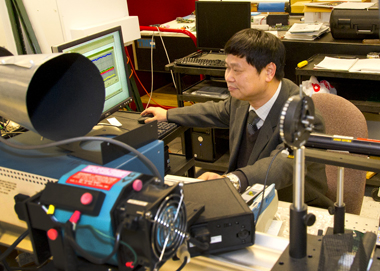UAlbany Scientist Seeking to Measure the Effects of Aerosols on Climate Change
 |
|
ASRC's Qilong Min works on innovative ways to measure how atmospheric aerosols from desert dust play a key role in climate change. (Photo by Mark Schmidt)
|
ALBANY, N.Y. (February 13, 2012) -- Qilong Min, Ph.D., Senior Research Associate and Professor with the Atmospheric Sciences Research Center (ASRC) at the University at Albany is developing innovative ways to measure how dust in the Sahara Desert can change clouds in the tropical Atlantic, the Caribbean region and Europe. This research will help scientists find better ways to estimate the impact dust has on climate change.
The National Science Foundation (NSF) awarded Min a three-year $399,900 grant to investigate how aerosol affects cloud systems. While many factors are at play, most cannot be accurately measured except by satellite.
Atmospheric aerosols play an important role in the climate. Aerosol is a colloid suspension of fine, solid particles in the air reflecting sunlight and producing cloud droplets. Additional aerosols would therefore brighten clouds and extend their lifetime. Mineral dust is one of four major sources of aerosols:
- Desert dust
- Sea salt
- The burning of living and dead vegetation, or biomass burning, and
- Anthropogenic air pollution, such as smoke and ash.
“Our observational study found the evidence of abundant cloud ice particles in the dust-impacted clouds,” said Min. “The effects of the dust aerosols shift the precipitation hydrometeor size from large to small, ultimately suppressing precipitation.”
Min’s research involves more accurate ways of measuring and modeling the cloud impacts of dust aerosols to help scientists predict the response of Earth’s climate to greenhouse gases.
Min earned a Ph.D. at the University of Alaska, Fairbanks, and joined the ASRC in 1994. Much of his research addresses the problems of atmospheric physics, ranging from the ionosphere to the earth´s surface, using numerical models and active and passive remote sensing from multiple platforms (satellite, airborne, and surface-based).
“We have developed an innovative analysis technique by integrating satellite and in-situ data from multiple instruments and platforms, and we also developed an advanced cloud-resolving model to simulate how mineral dust affects the development of tropical deep convective cloud systems,” said Min.
According to James Schwab, senior research associate at ASRC, African dust aerosols have been shown to be an important factor in the formation of tropical storms and hurricanes in the Atlantic.
“The transport and deposition of dust from one region to another has a variety of effects on the ecosystems involved. We have learned much about dust and its global effects on the environment in the past decade. Dr. Min’s research will certainly add to that knowledge,” Schwab said.
![]() For more news, subscribe to UAlbany's RSS headline feeds
For more news, subscribe to UAlbany's RSS headline feeds
A comprehensive public research university, the University at Albany-SUNY offers more than 120 undergraduate majors and minors and 125 master's, doctoral and graduate certificate programs. UAlbany is a leader among all New York State colleges and universities in such diverse fields as atmospheric and environmental sciences, business, education, public health,health sciences, criminal justice, emergency preparedness, engineering and applied sciences, informatics, public administration, social welfare and sociology, taught by an extensive roster of faculty experts. It also offers expanded academic and research opportunities for students through an affiliation with Albany Law School. With a curriculum enhanced by 600 study-abroad opportunities, UAlbany launches great careers.


